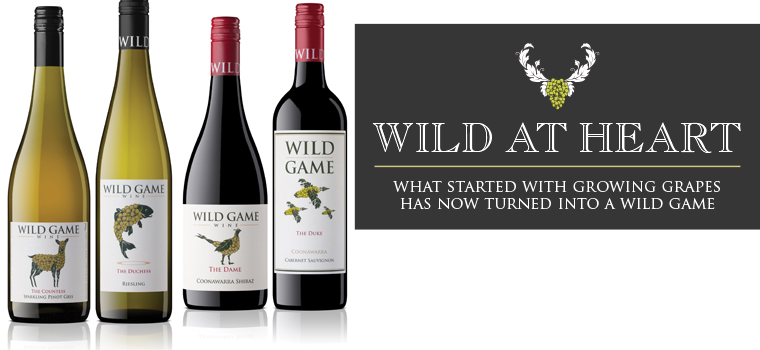What started with growing grapes has now turned into a Wild Game.
"This is a region that’s really gaining traction,” Mary says. “There’s a really high demand for its fruit so most of it will be sold for now. Currently we’re producing up to 500 cases of each of our four grape varieties, but our plan is for slow and certain growth."
NIGEL HOPKINS
NO, Wild Game doesn’t mean big game. More like small game, rather like the winery itself and the little critters that adorn its labels, such as ducks, deer, pheasants and fish.
But Wild Game Wine is growing fast with a recent major vineyard acquisition to add to the five- and seven-hectare vineyards on owners Mary and Guy Stratford’s farm on the north-eastern corner of the Coonawarra wine region. With its large natural swamp and flanked by forest and national park, a plentiful array of wild game also consider the farm home.
Mary and Guy between them have more than 50 years’ experience in the viticulture industry, Mary as a freelance viticulturist and Guy as an agricultural management consultant. The farm and its two vineyards they now own were ones that they at first managed, then leased and finally bought from renowned Coonawarra winemaker Peter Douglas a few years ago. It was Douglas who’d planted those vineyards with cabernet sauvignon and shiraz in the late 80’s and early 90’s.
“At first we sold most of the grapes but kept some and made wine for ourselves, friends and family,” Mary explains. “Then, in 2012 when we had some of the best cabernet we’d ever grown, the grape prices we were offered were so insulting, as it was across the industry, that we decided to ask our good friend Peter Douglas to process it into wine. The results were even better than we’d hoped for and we decided it was worth putting a label on it.”
Thus, Wild Game Wine was born with its first cabernet release The Duke. Putting ducks on the label was an easy choice, given they were such a prominent part of the local wild game, but The Duke?
“We searched for a name and in the end it just came down to Guy being a big fan of John Wayne, who’d probably never had a glass of wine in his life,” Mary says. Steadily other wines and labels followed – The Dame Shiraz with a pheasant on the label, The Duchess Riesling with silver perch, The Countess Sparkling Pinot Gris with deer.
The two white wines are sourced from Wild Game’s latest acquisition, a 30ha vineyard an hour’s drive from their home further south, closer to Mt Gambier. It marks a radical expansion for Wild Game.
“We’d been involved in its management over the years, and we knew its fruit was the most amazing quality, so when its owners asked us a year ago if we’d like to buy it, it seemed too good an opportunity to pass up.”
The cool climate vineyard has 10ha plantings each of pinot noir and sauvignon blanc, 5ha of chardonnay, and the remainder riesling and pinot gris.
“This is a region that’s really gaining traction,” Mary says. “There’s a really high demand for its fruit so most of it will be sold for now. Currently we’re producing up to 500 cases of each of our four grape varieties, but our plan is for slow and certain growth.”
Wild Game’s promise is already being realised, with its The Duchess Riesling scoring 97 points from Winestate’s judges.
Having the hugely experienced Peter Douglas on board as consultant winemaker has been an enormous advantage for Wild Game. Douglas, sometimes referred to as “Coonawarra’s master of Cabernet” and a former chief winemaker at Wynns Coonawarra Estate, makes the wine at DiGiorgio Family Wines in Coonawarra, where he is also the winemaker.
Another significant factor underpinning Wild Game Wine’s success is Mary’s two decades of viticultural experience that has created a passion for biological farming. This has led her to find innovative and cost-effective biological solutions using bacteria to deal with pests and diseases such as snails and botrytis, and protecting vines from frost damage.
It was the damaging frosts of the 2006-7 vintage that started Mary on the biological path when she studied the worst hit vineyards and found they all had in common the use of an organic spray that contained a specific bacteria that encourage frost damage. Her task then was to find a bacteria that neutralised the harmful bacteria.
“Everything we do is to encourage beneficial microbes in the soil and on the vines,” she says. “Farming organically is more about what you can’t use, but biological or regenerative farming is more about working with nature to keep the vines and soil in balance.”
They purchase specific biological products and bacteria that they brew up and deliver via Wild Game’s “beneficial bug cart”. Their botrytis spray, for example, also contains calcium, phosphorous, silicon and boron plus a special fungus. She says it’s been a process of trial and error rather than rigid scientific research, but the results have been both proven and cheaper than conventional chemical solutions.
Wild Game’s wines are still mostly sold either online or through the cellar door they’ve opened in Naracoorte, adjacent to the Naracoorte Art Gallery in a converted horse stable. A limited number of specialist wine cellars in Adelaide and Melbourne also stock Wild Game wines.

